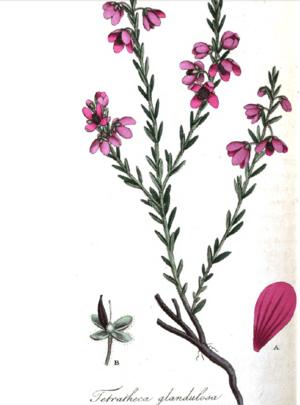Tetratheca glandulosa facts for kids
Quick facts for kids Tetratheca glandulosa |
|
|---|---|
 |
|
| t.21 | |
| Scientific classification | |
| Genus: |
Tetratheca
|
| Species: |
glandulosa
|
Tetratheca glandulosa is a special kind of shrub that spreads out. It belongs to a plant family called Elaeocarpaceae. You can only find this plant growing naturally in New South Wales, Australia.
Contents
What Does This Plant Look Like?
This shrub has interesting leaves. They can grow in different ways:
- Sometimes they grow one after another along the stem (alternate).
- Sometimes they grow in pairs, facing each other (opposite).
- Very rarely, you might see them in groups of three or four, like a small circle (whorls).
The leaves are long and narrow, like tiny lines. They are usually about 3 to 20 millimeters (mm) long and 1 to 2 mm wide. Their edges roll backwards, and they have stiff hairs. Some of these hairs have tiny glands at their tips, which makes the leaves look a bit like they have small teeth. The main vein on the underside of the leaf often has these gland-tipped hairs too. Sometimes, the leaves sit directly on the stem without a stalk.
Its Flowers and Fruit
The flowers of Tetratheca glandulosa usually grow one by one, though sometimes you might see two together. Each flower sits on a small stalk, about 3 to 10 mm long. These stalks can be hairy, with dark red hairs that have glands and bumpy bases.
The plant has small green parts called sepals, which are about 2 to 3 mm long. These sepals stay on the plant even after the flower turns into fruit. The petals are a beautiful deep lilac-pink color and are quite noticeable, measuring 4.5 to 10.5 mm long. They also stay on the plant as the fruit develops.
The part of the flower that holds the seeds (called the ovary) is hairy and contains two tiny seed parts (ovules). When the fruit forms, it is usually 3 to 7 mm long, and the seeds inside are bigger than 3 mm.
When Does It Flower?
This plant usually blooms from July to November.
Where Does It Grow?
You can find Tetratheca glandulosa growing in sandy or rocky areas. It likes heathlands (open, shrubby areas) or scrublands (areas with small trees and bushes). It grows in a region stretching from Mangrove Mountain to the Blue Mountains and around Sydney.
How Did It Get Its Name?
The plant Tetratheca glandulosa was first officially described by a scientist named James Edward Smith in the year 1804.
The second part of its name, glandulosa, comes from a Latin word, glandula, which means "gland." So, the name glandulosa describes the plant as "bearing glands" or "having glands." This makes sense because, as we learned, its leaves and flower stalks often have tiny gland-tipped hairs!
Is It in Danger?
In New South Wales, this plant has been officially listed as "vulnerable." This means that it is facing a high risk of becoming extinct in the wild in the future if we don't protect it.

